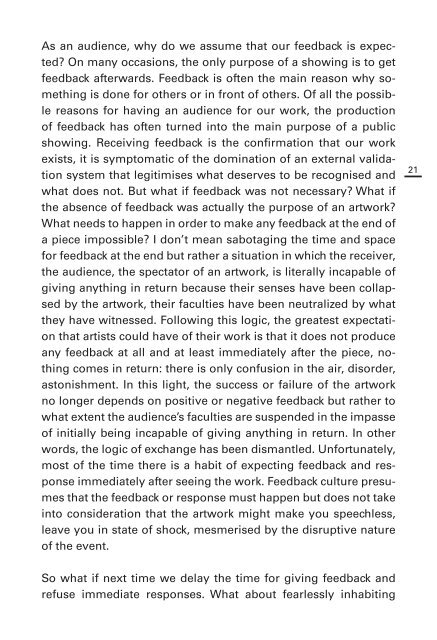Laboratory on Feedback in Artistic Processes 3
In its third edition the "Laboratory on Feedback in Artistic Processes" reflects on "Responses" within performing arts. The results of the previous Labs highlighted the need to take a closer look at the complexity and often subtle implications of feedback within the the artistic process itself. How do artist organise feedback and how do they process it? Who they want feedback from and what are its different roles? How can describe these relationships, and how does it shpae the artistic work? This booklet presents the different views on and experiences of feedback practices that were elaborated during the lab along the beforementioned questions and the insightfull contributions of its participants. Underpinning the following pages, three thematic fields have emerged: the impacts of feedback, feedback as a tool, and practicalities and contexts of feedback.
In its third edition the "Laboratory on Feedback in Artistic Processes" reflects on "Responses" within performing arts. The results of the previous Labs highlighted the need to take a closer look at the complexity and often subtle implications of feedback within the the artistic process itself. How do artist organise feedback and how do they process it? Who they want feedback from and what are its different roles? How can describe these relationships, and how does it shpae the artistic work?
This booklet presents the different views on and experiences of feedback practices that were elaborated during the lab along the beforementioned questions and the insightfull contributions of its participants. Underpinning the following pages, three thematic fields have emerged: the impacts of feedback, feedback as a tool, and practicalities and contexts of feedback.
Create successful ePaper yourself
Turn your PDF publications into a flip-book with our unique Google optimized e-Paper software.
As an audience, why do we assume that our feedback is expected?<br />
On many occasi<strong>on</strong>s, the <strong>on</strong>ly purpose of a show<strong>in</strong>g is to get<br />
feedback afterwards. <strong>Feedback</strong> is often the ma<strong>in</strong> reas<strong>on</strong> why someth<strong>in</strong>g<br />
is d<strong>on</strong>e for others or <strong>in</strong> fr<strong>on</strong>t of others. Of all the possible<br />
reas<strong>on</strong>s for hav<strong>in</strong>g an audience for our work, the producti<strong>on</strong><br />
of feedback has often turned <strong>in</strong>to the ma<strong>in</strong> purpose of a public<br />
show<strong>in</strong>g. Receiv<strong>in</strong>g feedback is the c<strong>on</strong>firmati<strong>on</strong> that our work<br />
exists, it is symptomatic of the dom<strong>in</strong>ati<strong>on</strong> of an external validati<strong>on</strong><br />
system that legitimises what deserves to be recognised and<br />
what does not. But what if feedback was not necessary? What if<br />
the absence of feedback was actually the purpose of an artwork?<br />
What needs to happen <strong>in</strong> order to make any feedback at the end of<br />
a piece impossible? I d<strong>on</strong>’t mean sabotag<strong>in</strong>g the time and space<br />
for feedback at the end but rather a situati<strong>on</strong> <strong>in</strong> which the receiver,<br />
the audience, the spectator of an artwork, is literally <strong>in</strong>capable of<br />
giv<strong>in</strong>g anyth<strong>in</strong>g <strong>in</strong> return because their senses have been collapsed<br />
by the artwork, their faculties have been neutralized by what<br />
they have witnessed. Follow<strong>in</strong>g this logic, the greatest expectati<strong>on</strong><br />
that artists could have of their work is that it does not produce<br />
any feedback at all and at least immediately after the piece, noth<strong>in</strong>g<br />
comes <strong>in</strong> return: there is <strong>on</strong>ly c<strong>on</strong>fusi<strong>on</strong> <strong>in</strong> the air, disorder,<br />
ast<strong>on</strong>ishment. In this light, the success or failure of the artwork<br />
no l<strong>on</strong>ger depends <strong>on</strong> positive or negative feedback but rather to<br />
what extent the audience’s faculties are suspended <strong>in</strong> the impasse<br />
of <strong>in</strong>itially be<strong>in</strong>g <strong>in</strong>capable of giv<strong>in</strong>g anyth<strong>in</strong>g <strong>in</strong> return. In other<br />
words, the logic of exchange has been dismantled. Unfortunately,<br />
most of the time there is a habit of expect<strong>in</strong>g feedback and resp<strong>on</strong>se<br />
immediately after see<strong>in</strong>g the work. <strong>Feedback</strong> culture presumes<br />
that the feedback or resp<strong>on</strong>se must happen but does not take<br />
<strong>in</strong>to c<strong>on</strong>siderati<strong>on</strong> that the artwork might make you speechless,<br />
leave you <strong>in</strong> state of shock, mesmerised by the disruptive nature<br />
of the event.<br />
21<br />
So what if next time we delay the time for giv<strong>in</strong>g feedback and<br />
refuse immediate resp<strong>on</strong>ses. What about fearlessly <strong>in</strong>habit<strong>in</strong>g


















